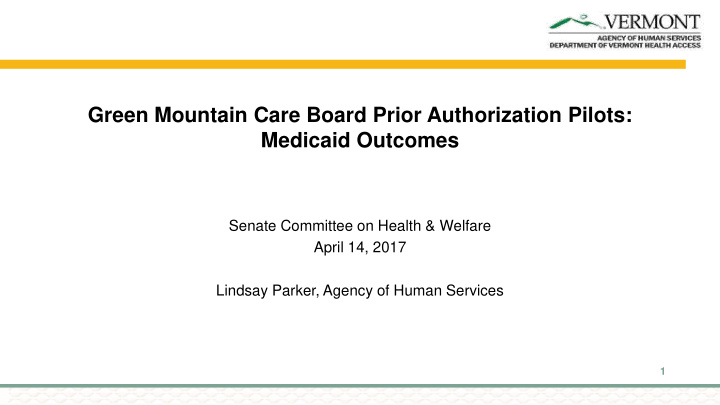



Green Mountain Care Board Prior Authorization Pilots: Medicaid Outcomes Senate Committee on Health & Welfare April 14, 2017 Lindsay Parker, Agency of Human Services 1
Radiology Pilot Design • Requests for MRI for lower back pain at two hospitals (Rutland Regional Medical Center & Porter Medical Center) • Prior authorization replaced by real time decision-support at the Radiology Department based on clinical criteria (American College of Radiology Appropriateness Criteria) • Pilot ran May 2015 to May 2016 • Participating payers: Medicaid, BCBSVT, MVP 2
Radiology Pilot - Results Findings • Low volume of tests ordered with two providers; Difficult to find meaningful differences. • Feedback from providers: New process was administratively burdensome and would be difficult to apply to all imaging services in place of existing PAs. PA Pilot – Utilization Data for Medicaid (based on paid claims) Provider Number of MRIs- Number of MRIs- % Change Pre-Pilot (with PA) Pilot (no PA) 5/1/14 - 4/30/15 5/1/15 - 4/30/16 Porter Medical 71 77 8.5% Center Rutland Regional 338 384 13.6% Medical Center Total 409 461 12.7% 3
Gold Card Program Current Medicaid Program for Imaging • In 2013, DVHA began issuing “Gold Cards” to providers with exceptional records of making referrals for hi-tech imaging services that are aligned with current clinical criteria. • If issued a Gold Card, a provider is exempt from PA requirements. Cards are renewed annually. • To qualify, a provider must make at least 100 imaging requests over 18 months and have a denial rate of PAs of < 3%. • Currently, there are 13 participating Gold Card providers. 4
Pharmacy Pilot Design • Two drug classes: Statins (cholesterol) and Proton Pump Inhibitors (acid reflux) • Prior authorizations waived • Pilot ran May 2015 to July 2016 • Participating payers: Medicaid, BCBSVT, MVP 5
Pharmacy Pilot - Results Findings Statins • No change in utilization during the pilot; because most products were preferred by Medicaid before the pilot. Proton Pump Inhibitors • Increased use of non-preferred products; deviation from the stable preferred/non-preferred mix of products that Medicaid saw before the pilot. • Increase of 29.7% in costs associated with non-preferred drug utilization during the pilot (compared to pre-pilot baseline). • Medicaid would have seen an increase in costs of $250K-$350K if the pilot had been continued and expanded. 6
Recommend
More recommend